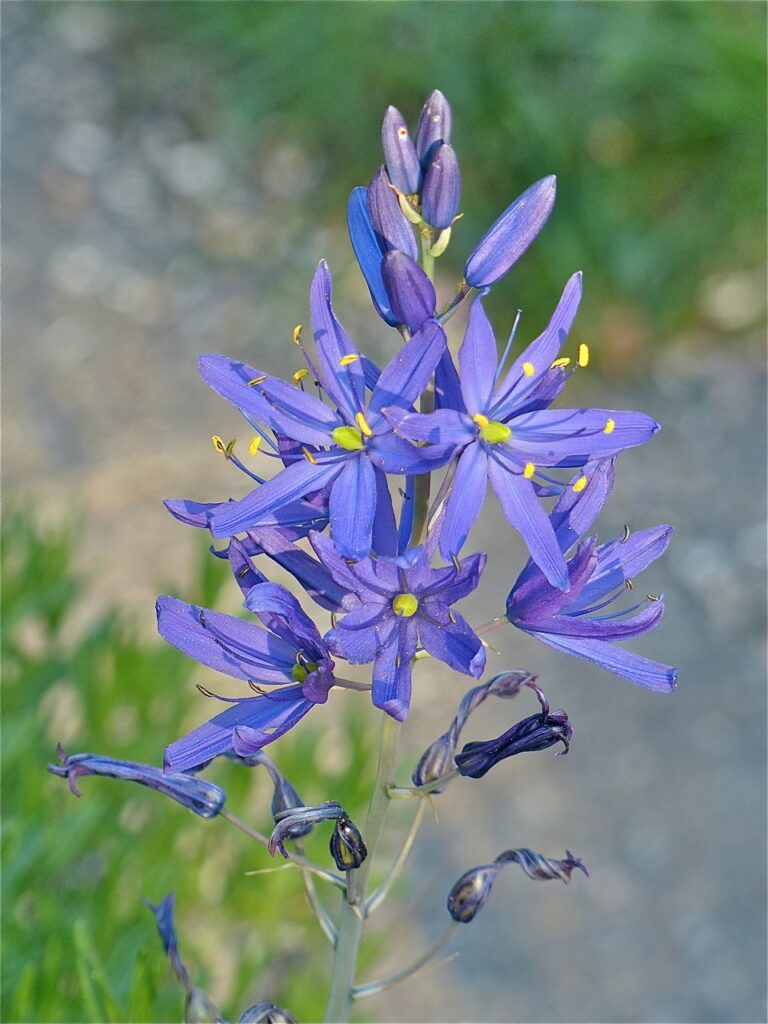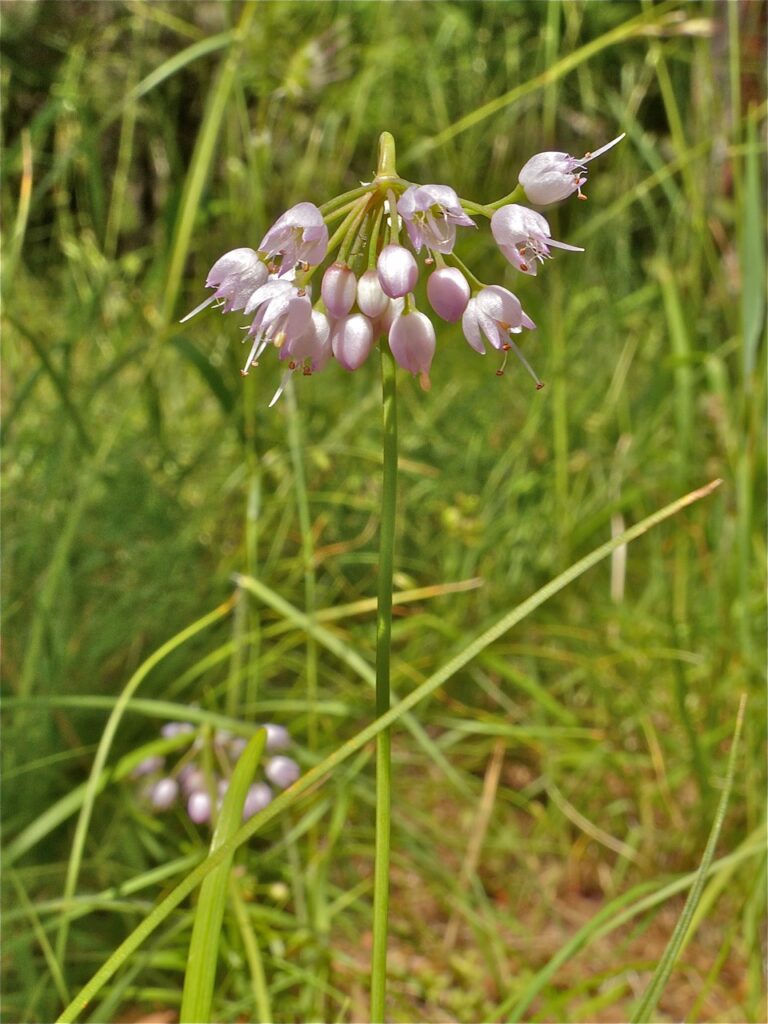
Chocolate Lily (Fritillaria affinis)
In early February, Jericho Stewardship Group volunteers planted over 100 bulbs of native wildflowers, including White Fawn Lily (Erythronium oregonum), Pink Fawn Lily (Erythronium revolutum), Great Camas (Camassia leichtliniii), Nodding Onion (Allium cernuum), Chocolate Lily (Fritillaria affinis), and Northern Rice Root (Fritillaria camschatcensis). The bulbs were the very generous gift of volunteers with the Wildflower Rewilding Project of the Vancouver Botanical Garden Association. If all goes well, they will also have a small number of Western Trillium (Trillium ovatum) and Shooting Star (Dodecatheon) to share with Jericho later this year.
Many of these plants may once have grown in Jericho, but they have not been seen here for decades. (The exception is camas: a few were planted along the shore in 2013 as part of the Jericho Beach Restoration Project.) Camas, wild onion, and the chocolate lily were important food plants for local indigenous people. Camas beds were owned and cultivated by particular families. They were harvested right after flowering so that the bulbs would not be confused with those of the poisonous death-camas (Zygadenus venenosus), which has a white flower. The bulbs were then steamed for a day and a night and then eaten or dried for storage. The Fritillaria bulbs were steamed for a shorter period of time and mashed. The bulblets surrounding the main bulb are said to taste like rice.

White Fawn Lily (Erythronium oregonum)
Most of these plants are now rare in the Lower Mainland, and raising them is not a simple matter of tossing seeds in the ground. We talked to Rich Hankin and Heather Merilees of the Rewilding Project about their work.
Where did you get the seeds?
I collect E. oregonum wild in the Fraser Valley. The E. revolutum are from my garden, from plants that I collected wild decades ago on the Oyster River on Vancouver Island. The Allium, Camassia, and Fritillarias were collected by B.C. Alpine Garden Club members from plants in the wild or from members’ gardens.
How long did it take for the seeds to germinate?
Most germinate the spring following collection, often after being subjected to winter cold or refrigeration. Some seeds, like those of the Trillium, must be sown immediately following harvesting while many others benefit from fresh sowing but also seem to do fine if they are stored dry and cool. After germination the plants are left for at least one full year to develop small bulbs and then they are planted out in deeper pots typically with small clusters of the young bulbs. Some of the non-bulb species we grow will bloom the first or second season: for example, the native columbine, Aquilegia formosa, can often bloom in the first fall, and certainly by the next spring; Dodecatheon species can bloom the second spring or summer.
Trillium ovatum is in a class of its own. The seeds must be planted right after harvest in July; in the first year they show no growth above ground. A first small seed leaf appears in year two but it’s a total of seven years before the plant will flower. We’re just coming into the third spring with our seedlings. Division of the rhizome while mature plants are in bloom is much easier and quicker: it takes about two years for the Trillium plants to come back to strong, blooming size. The three pots of Trillium we have for Jericho come from a “rescue” opportunity we had on a 3.5 acre wooded site in North Surrey. It was about to be cleared for a 26 lot subdivision. From it we got more than 25 pots with 2 to 5 stems each

Great Camas (Camassia leichtliniii)
How do you care for the new plants?
Mostly it just takes time! The natives are used to being wet in winter and spring and almost completely dry by summer; the Erythronium are dormant by then, while some of the others persist later but eventually are mostly dry and dormant by late summer. They are really not that difficult to care for. They have been seeded in flats and then in deeper pots. The Erythroniums are placed in relatively sunny places while emerging and in leaf, then moved to shade as they begin to die down and need only minimal summer watering. Others like the Camassia and allium need more sustained sun and/or semi-shade. We have found it less time-consuming to begin with to plant Erythronium in deeper trays or pots because of their ability to pull themselves deeper as they grow; they emerge out the bottom of, say, 2″ deep flats or even 4″ deep pots in just two growing seasons.. In just a few years they are 8″ or 10″ deep.
How long does it take for the plants to become established and start to bloom?
The Erythronium are typically in their fourth spring for the majority to bloom; the Camassia and Fritillaria we hope will flower – some of them- in the third year. The Allium seem to have bloomed in two years. We hope that some of the bulbs we planted in Jericho will bloom this year.
How likely is it that these plants did once grow at Jericho?
Fritillaria camschatsensis is formally recorded [in the Beaty Herbarium and E-Flora B.C.] as having been collected at Jericho. There are a few Camassia leichtlinii at Jericho, but these were recently planted by the Park Board. Fritillaria affinis I was told had been reported by Bert Brink at Point Grey, so I think it’s a possibility for the park, along with the Allium cernuum. Erythronium oregonum occurs in quite a few places in the Fraser Valley, so I think it is very likely that it once grew at Jericho too. The E. revolutum is less likely to have been here. It has been reported on the Lower Mainland only from High Knoll Park in Surrey, and there is some doubt as to whether it is native there. However, many areas of the Lower Mainland were probably never inspected prior to land clearing in the 1800s, so we really don’t know. But all of these species will grow in this region if planted in suitable settings.
If anyone knows of any property (wild or garden) being developed or redeveloped that contains natives that we can salvage, we’d like to know about it. Please contact Jericho Stewardship Group and we will pass on the information.

Nodding Onion (Allium cernuum)
All photos in this section are by Rosemary Taylor.